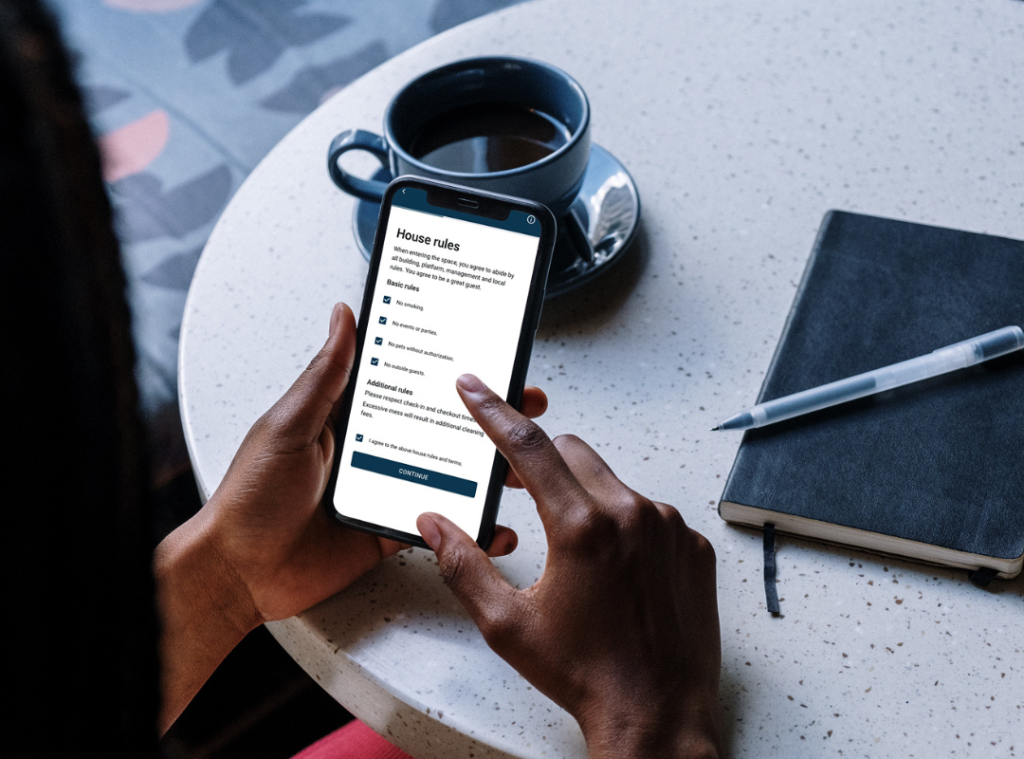The management of a resort requires a delicate balance. It’s easy to feel overburdened trying to satisfy guests, coordinate team members, and maintain operational efficiency.
This guide focuses on actionable strategies for short-term rental hosts and property managers looking to simplify their day-to-day operations and stay on top of it all.
Automate Front Desk Operations
Start with repetitive tasks that consume hours but don’t directly enhance the guest experience. Automating check-ins, check-outs, and guest communications can save time and reduce human error. Use software that syncs with your booking platforms to send pre-scheduled emails or text messages with access codes, property instructions, and checkout reminders.
Consider Keyless entry systems that eliminate the need for physical keys or on-site staff during check-ins. You can also use a chatbot to answer common guest queries about Wi-Fi, local attractions, or property rules.

Audit your current tools to ensure they integrate seamlessly. A clunky system can create more headaches than it solves.
Standardize Housekeeping Procedures
Housekeeping is one of the most visible aspects of a well-run resort. Create detailed cleaning checklists to minimize room-to-room variability and ensure high standards are consistently met. Include photos of how items should be arranged in each room to remove guesswork for your team.
– Mobile apps like Properly for assigning tasks and tracking progress in real-time.
– QR codes in supply closets that link to restocking instructions or order forms.
Encourage team accountability with digital tracking. For example, require photos of completed rooms to confirm standards before guests arrive. This step doesn’t just help you—it empowers your staff with clear expectations.
Centralize Maintenance Reporting
Equipment breakdowns and maintenance delays can derail even the best-planned schedule. To prevent small issues from snowballing, centralize how your team reports and tracks maintenance problems.
Here’s how to implement it:
1. Use a digital work order system where employees can log issues with photos and descriptions.
2. Categorize problems by urgency, from minor (lightbulb replacements) to critical (HVAC failures).
3. Assign deadlines and notify team members instantly when tasks are updated.
For high-traffic resorts, a preventive maintenance schedule is non-negotiable. Regular inspections of HVAC systems, plumbing, and high-use appliances can avoid unexpected downtime.
Simplify Staff Scheduling
Staffing shortages are common in hospitality, but chaotic scheduling only makes things worse. Use a shift scheduling app to streamline who works when, track hours, and accommodate requests for time off.
Keep communication open by allowing team members to swap shifts directly in the app (with manager approval). Automating schedule creation based on demand trends—like holidays or peak check-in days—can also reduce guesswork.
Analyze your busiest check-in and check-out windows. Ensure additional staff is always allocated during those times to manage workload surges.
Outsource Non-Core Tasks
Outsourcing isn’t just for big hotels; even smaller properties can benefit. Focus on your core responsibilities, like guest relations, while offloading other tasks to third-party providers.
– Laundry services to a vendor who specializes in commercial cleaning.
– Landscaping and pest control to professional services for consistent results.
– Nighttime customer support to a 24/7 answering service that ensures guests always have someone to reach.
Outsourcing doesn’t mean you’re losing control. Use software to track vendor performance and ensure they meet your expectations.
Monitor Guest Feedback in Real-Time
Feedback can be your best friend or your worst enemy, depending on how quickly you respond. Setting up alerts for new reviews or guest complaints allows you to address issues as they arise, turning potential problems into opportunities for positive impressions.
– Email notifications for new reviews on platforms like Airbnb or Booking.com.
– Surveys sent immediately after checkout to gauge guest satisfaction.
Turn critical feedback into action by sharing it with your team. If a guest comments on slow service or maintenance delays, include this in training sessions to prevent recurrence.
Use Data to Predict Demand
Resorts can’t thrive on guesswork. Use analytics to understand occupancy trends, peak booking periods, and revenue drivers. This data can help you allocate resources, adjust pricing, and plan marketing campaigns effectively.
Tips for better demand forecasting:

– Review historical booking data to anticipate seasonal highs and lows.
– Monitor competitor pricing to ensure you remain competitive without underselling your value.
– Track add-on purchases (like spa treatments or excursions) to identify upselling opportunities.
A smart pricing tool can automate much of this process by analyzing market trends and suggesting real-time adjustments to maximize profitability.
Streamline Communication Across Teams
Miscommunication can disrupt even the best-laid plans. Whether it’s housekeeping, maintenance, or front desk staff, ensure everyone is aligned with a unified communication tool.
– Slack or Microsoft Teams for instant team updates.
– Task management platforms like Asana to assign and monitor progress on property-wide projects.
Avoid bottlenecks by setting communication protocols. For example, urgent issues can be flagged via text or calls, while less critical updates are reserved for team meetings or email threads.
Optimize Energy Usage
Energy costs are a major operational expense for resorts. Optimizing your energy usage doesn’t just cut costs—it also supports sustainable practices that modern travelers value.
– Install motion sensors for lights in common areas.
– Switch to energy-efficient appliances and LED bulbs throughout the property.
– Use smart thermostats to regulate temperature based on occupancy.
If your budget allows, consider renewable energy options like solar panels. Over time, the savings can offset initial installation costs.
Train for Problem-Solving, Not Just Procedures
Every property manager knows that things don’t always go according to plan. While standard procedures are important, teaching your team how to handle unexpected situations with confidence can make a significant difference.
Role-playing exercises during team meetings can prepare employees for real-life scenarios, like:
– Handling last-minute guest complaints.
– Resolving overbookings.
– Communicating delays for maintenance or housekeeping.
Empowered teams make better decisions, and guests will notice the difference.
Conduct Monthly Performance Reviews
It’s easy to overlook small inefficiencies when you’re focused on daily operations. A monthly review helps you spot trends and adjust your strategy as needed.
During your review:
1. Analyze occupancy rates, revenue, and guest feedback to identify successes and areas for improvement.
2. Meet with department leads to discuss challenges they’re facing and brainstorm solutions.
3. Set clear goals for the next month and assign ownership for achieving them.
The more consistent you are with these reviews, the better prepared you’ll be to pivot quickly and maintain smooth operations.
Streamlining resort operations is less about reinventing the wheel and more about refining the processes you already have in place. By focusing on automation, communication, and continuous improvement, you can create an experience that’s both seamless for your team and memorable for your guests.





